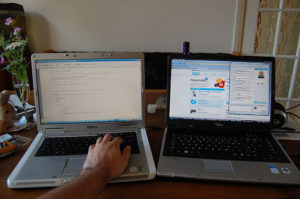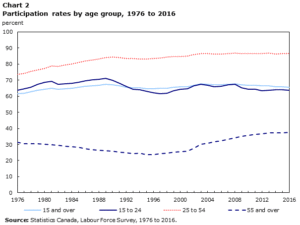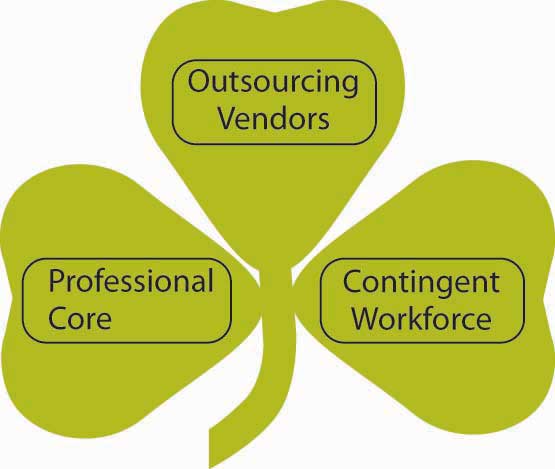1.5 Trends and Changes
[Author removed at request of original publisher] and Venecia Williams
Learning Objectives
- Understand current challenges for OB
- Understand current opportunities for OB
Challenges and Opportunities
There are many trends within the workplace and around the globe that have and will continue to affect the workplace and your career. We are sure you have noticed many of these trends simply by reading newspaper headlines. We will highlight some of these trends along with the challenges and opportunities they present for students of organizational behaviour.
Ethical Challenges
Business ethics refers to applying ethical principles to situations that arise at work. It feels like it’s been one ethical scandal after the other. Enron Corp., AIG, Tyco International, WorldCom, and SNC-Lavalin have all been examples of what can be described in terms ranging from poor judgment to outright illegal behaviour. The response by the Canadian government has been Bill 198, which went into effect in 2003. This act consists of different requirements aimed at greater accountability, which companies must comply with in terms of financial reporting. And while there may be some benefit to businesses from complying with these rules, few see this as the long-term solution to dealing with unethical behaviour. The challenge is to continue to think about business ethics on a day-to-day basis and institute cultures that support ethical decision making. The opportunity for organizations to be at the forefront of ethical thinking and actions is wide open. OB research finds that the most important determinant of whether a company acts ethically is not necessarily related to the policies and rules regarding ethical conduct but instead whether it has a culture of consistently ethical behaviour and if leaders are committed to this ethical behaviour (Driscoll & McKee, 2007).
OB Toolbox: Take an Ethics-at-Work Audit
- Do you integrate ethics into your day-to-day decisions at work? It’s easy to think about ethics as something big that you either have or don’t have, but the reality is that ethical decisions are made or not made each and every day.
- Do you take the “front page” test when making important decisions at work? Thinking about how you would feel if the decisions you are making at work showed up on the front page of your local newspaper can help you avoid engaging in questionable behaviour.
- Do you role model ethics at work? Seeing others engage in unethical behaviour is the start of a slippery slope when it comes to ethics. Consider the decisions you are making and how they are consistent or inconsistent with how you would like to be seen by others.
- Do you consider if rewards are distributed ethically at work? Situations in which there are “haves” and “have nots” are breeding grounds of unethical behaviour. Maintaining pay equity can help keep everyone more honest.
- Have you held a “risk brainstorm” at work? If you ask those around you if they see any situations that are challenging ethical behaviour, you can uncover some seriously risky situations and avoid them.
Sources: Adapted from ideas in Callahan, D. (2004). The cheating culture: Why more Americans are doing wrong to get ahead. New York: Harcourt Books; Toffler, B. L. (2003). Five ways to jump-start your company’s ethics. Fast Company. Retrieved May 4, 2008, from http://www.fastcompany.com/magazine/75/5ways.html; Trevino, L. K., Weaver, G. R., & Reynolds, S. J. (2006). Behavioral ethics in organizations: A review. Journal of Management, 32, 951–990.
Lack of Employee Engagement
Studies suggest that fostering engagement, a concept related to passion, in employees has a significant impact on the corporate bottom line. Employee engagement is a concept that is generally viewed as managing discretionary effort, that is, when employees have choices, they will act in a way that furthers their organization’s interests. An engaged employee is a person who is fully involved in and enthusiastic about their work (Employee engagement, 2008). The consulting firm BlessingWhite offers this description of engagement and its value: “Engaged employees are not just committed. They are not just passionate or proud. They have a line-of-sight on their own future and on the organization’s mission and goals. They are ‘enthused’ and ‘in gear’ using their talents and discretionary effort to make a difference in their employer’s quest for sustainable business success” (BlessingWhite, 2008). Engaged employees are those who are performing at the top of their abilities and happy about it.
Technology
Figure 1.5

Technology has transformed the way work gets done and has created many great opportunities. The nexus of increasing personal computing power, the Internet, as well as nanotechnology are allowing things to be created that weren’t even imaginable 50 years ago. And the rate of technological change is not expected to slow down anytime soon. Gordon Moore, a co-founder of Intel Corp., shocked the world in 1975 with what is now termed Moore’s Law, which states that computing power doubles every 2 years. This explains why a 4-year-old computer can barely keep up with the latest video game you have purchased. As computers get faster, new software is written to capitalize on the increased computing power. We are also more connected by technology than ever before. In fact, over 293 billion emails were sent for business in 2019 (Techjury, 2019). Technology has also brought a great deal of challenges to individuals and organizations alike. To combat the overuse of email, companies such as Intel have instituted “no email Fridays,” in which all communication is done via other communication channels. The technology trend contains challenges for organizational behaviour.
Flattening World
Thomas Friedman’s book The World Is Flat: A Brief History of the Twenty-First Century makes the point that the Internet has “flattened” the world and created an environment in which there is a more level playing field in terms of access to information. This access to information has led to an increase in innovation, as knowledge can be shared instantly across time zones and cultures. It has also created intense competition, as the speed of business is growing faster and faster all the time. In his book Wikinomics, Don Tapscott notes that mass collaboration has changed the way work gets done, how products are created, and the ability of people to work together without ever meeting.
There are few barriers to information today, which has created huge opportunities around the globe. Marc Andreessen, co-founder of Netscape Communications Corporation, notes, “Today, the most profound thing to me is the fact that a 14-year-old in Romania or Bangalore or the Soviet Union or Vietnam has all the information, all the tools, all the software easily available to apply knowledge however they want” (Friedman, 2005) Of course, information by itself is not as important as having the right information at the right time. A major challenge for individuals in the flattened world is learning how to evaluate the quality of the information they find. For tips on how to evaluate the quality of information, see the OB Toolbox below.
OB Toolbox: Tips for Evaluating the Quality of Information
Here are a few Internet resources to refer to when evaluating information you find on the Web:
Sustainability and Green Business Practices
The primary role of for-profit companies is to generate shareholder wealth. More recently, the concept of the triple bottom line has been gaining popularity. Those subscribing to the triple bottom line believe that beyond economic viability, businesses need to perform well socially and environmentally. While some organizations have embraced the concepts underlying the triple bottom line, businesses are also undergoing a great deal of “greenwashing,” which refers to the marketing of products or processes as green to gain customers without truly engaging in sustainable business practices. Sustainable business practices are those that meet the present needs without compromising the needs of future generations. The challenge is to reconcile the accountability that publicly owned firms have in generating wealth for their shareholders while attending to the triple bottom line. On the other hand, organizations also have an opportunity to leverage a proactive stance toward innovative processes that can result in even greater profits for their products. For example, sales of the Toyota Prius, which combines combustion engine efficiency with hybrid-electric technology, have been dramatic and have helped propel Toyota to record market share and profits. An unlikely leader in the sustainability movement is Wal-Mart. Wal-Mart hired Adam Werbach, the former president of the Sierra Club, to help train 1.3 million North American Wal-Mart employees about sustainability. Wal-Mart has also been pressuring suppliers to produce compact fluorescent lightbulbs with less mercury and has slashed the resources needed in packaging by requiring all suppliers to make packages smaller (Fetterman, 2006; Sacks, 2007). In the future, increasing interdependence between businesses, governmental agencies, and NGOs is bound to effect change throughout the economy (Campbell, 2007; Etzion, 2007).
Aging Workforce and the Millennial Generation
Globally, the workforce is aging and Canada is no exception. A study by Statistics Canada indicates that in 2016, 36% of the workforce was aged 55 and over and by 2026 that number could reach 40% (2017). Many assumptions are made about an older workforce. They can contribute positively to the work environment due to their lower rates of absenteeism, lower turnover and workplace loyalty (CCOHS, n.d.). On the other hand, they are negatively stereotyped as being unable or unwilling to learn new technology, being less competent and being less productive (McMaster University, 2019). Assumptions, whether positive or negative, can affect the attitudes of organizations toward older workers. With the clear benefits of an age-diverse workforce coupled with the increasing number of older workers opting to remain in the Canadian workforce after 55, organizations need to ensure the work environment is conducive to equal participation of all employees.
Figure 1.6

The Millennial Generation (which includes those born between 1980 and 2000) differs from previous generations in terms of technology and multitasking as a way of life. Having never known anything different, this population has technology embedded in their lives. In addition, they value teamwork, feedback, and challenging work that allows them to develop new skills. If you are in this generation or know those who are, you know there is an expectation of immediate interaction (Oblinger, 2003). The challenge for organizational behaviour is to keep individuals from different generations communicating effectively and managing people across generational lines despite different values placed on teamwork, organizational rewards, work-life balance, and desired levels of instruction.
The Global Marketplace for Staffing: Outsourcing
Figure 1.7

Outsourcing has become a way of life for many organizations—especially those based in the United States that are outsourcing to other countries where labour is relatively inexpensive. Outsourcing refers to having someone outside the formal ongoing organization doing work previously handled in-house. This practice can involve temporary employees, consultants, or even offshoring workers. Offshoring means sending jobs previously done in one country to another country. Nowhere is there more outsourcing and offshoring than in the software technology industry. A survey of software developers revealed that 94% outsource project work, and when they offshore, the work most frequently goes to India, Singapore, Russia, and China (McGee, 2007). Microsoft has been expanding their use of employees in Canada for a variety of reasons such as closer proximity to Microsoft’s headquarters in Seattle, Washington, as well as similarity of language and time zones. Across industries, more than 80% of boards of directors in the United States have considered offshore outsourcing (Diana, 2003).
Charles Handy, author of The Age of Paradox, coined the term shamrock organization, which is an organization comprising one-third regular employees, one-third temporary employees, and one-third consultants and contractors. He predicts that this is where organizations are headed in the future. The darker side of the changing trend in organization composition revolves around potential unemployment issues as companies move toward a shamrock layout. Fortunately, this shift also presents an opportunity for organizations to staff more flexibly and for employees to consider the tradeoffs between consistent, full-time work within a single organization versus the changing nature of work as a temporary employee, contract worker, or consultant—especially while developing a career in a new industry, in which increased exposure to various organizations can help an individual get up to speed in a short amount of time. The challenge for organizational behaviour is managing teams consisting of different nationalities separated not only by culture and language but also in time and space.
Key Takeaway
Trends include ethical challenges, rapid technological change, a flattening world, sustainable business practices, demographic trends, and the global marketplace. A number of trends will influence the way work gets done today and in the future. Understanding organizational behaviour will help you anticipate and adapt to these changes as a lifelong learner.
Exercises
- Share an ethical dilemma you have observed at work or school to someone in your class. What do you think should have been done differently and why?
- How has technology and the flattening world affected you in the last 10 years? Please share examples of this.
- Do you think the sustainability movement in business is a trend that’s here to stay or a business fad? Why or why not?
- Do you see the aging (and retiring) workforce as an opportunity or a threat for businesses? How do you think this will affect your career?
References
BlessingWhite. (2008, April). 2008 Employee engagement report. Retrieved May 15, 2008, from the BlessingWhite Inc. Web site: http://www.blessingwhite.com/eee__report.asp.
Campbell, J. L. (2007). Why would corporations behave in socially responsible ways? An institutional theory of corporate social responsibility. Academy of Management Review, 32, 946–967.
Canadian Centre For Occupational Health And Safety. (n.d.). The Aging Workforce in Canada. Retrieved April 30, 2020, from https://www.ccohs.ca/products/posters/longdesc/aging_workforce.html
Diana, A. (2003, November 12). Outsourcing by the numbers. TechNewsWorld. Retrieved May 22, 2008, from http://www.technewsworld.com/story/32114.html?welcome=1211412779&welcome=1211478843.
Driscoll, K., & McKee, M. (2007). Restorying a culture of ethical and spiritual values: A role for leader storytelling. Journal of Business Ethics, 73, 205–217.
Etzion, D. (2007). Research on organizations and the natural environment, 1992–present: A review. Journal of Management, 33, 637–664.
Fetterman, W. (2006). Wal-Mart grows “green” strategies. USA Today. Retrieved June 1, 2008, from http://www.usatoday.com/money/industries/retail/2006-09-24- wal-mart-cover-usat_x.htm.
Fields, Andrew, Sharanjit Uppal and Sébastien LaRochelle-Côté. (2017). ” The impact of aging on labour market participation rates.” Insights on Canadian Society. June. Statistics Canada Catalogue no. 75-006-X.
Friedman, T. L. (2005, April 3). It’s a flat world, after all. New York Times. Retrieved June 1, 2008, from http://www.nytimes.com/2005/04/03/magazine/03DOMINANCE.html.
McMaster University. (2019, May 8). Combating ageism in the workplace. Retrieved April 30, 2020, from https://www.mcmasteroptimalaging.org/blog/detail/blog/2019/05/08/combating-ageism-in-the-workplace
McGee, M. K. (2007, October 2). Canada wants to become the next India for U.S. software companies. Information Week. Retrieved May 22, 2008, from http://www.informationweek.com/news/management/showArticle.jhtml?articleID=202200301.
Oblinger, D. (2003). Boomers, Genexers and Millennials: Understanding the new students. Educause Review. Retrieved June 2, 2008, from http://net.educause.edu/ir/library/pdf/ERM0342.pdf.
Sacks, D. (2007, December 19). Working with the enemy. Fast Company. Retrieved June 1, 2008, from http://www.fastcompany.com/magazine/118/working-with-the-enemy.html.
Statistics Canada. (2017, June 14). Insights on Canadian Society The impact of aging on labour market participation rates. Retrieved April 30, 2020, from https://www150.statcan.gc.ca/n1/pub/75-006-x/2017001/article/14826-eng.htm
Taylor, C. (2002, June 10). 12 Steps for email addicts. Time.com. Retrieved October 14, 2008, from http://www.time.com/time/magazine/article/0,9171,1002621,00.html.
Techjury. (2019, February 19). How Many Emails Are Sent Per Day: The Startling Truth [2020]. Retrieved May 1, 2020, from https://techjury.net/stats-about/how-many-emails-are-sent-per-day/#gref
Wagner, S., & Dittmar, L. (2006, April). The unexpected benefits of Sarbanes-Oxley. Harvard Business Review, 84, 133–140.
Watson, B. (2008, January 30). Aviation. Retrieved June 1, 2008, from the MSNBC Web site: http://www.msnbc.msn.com/id/22917202/.
Zinkewicz, P. (2005, April 11). Satisfaction (not) guaranteed. Retrieved October 29, 2008, from the Age Wave Web site: http://www.agewave.com/media_files/rough.html.

